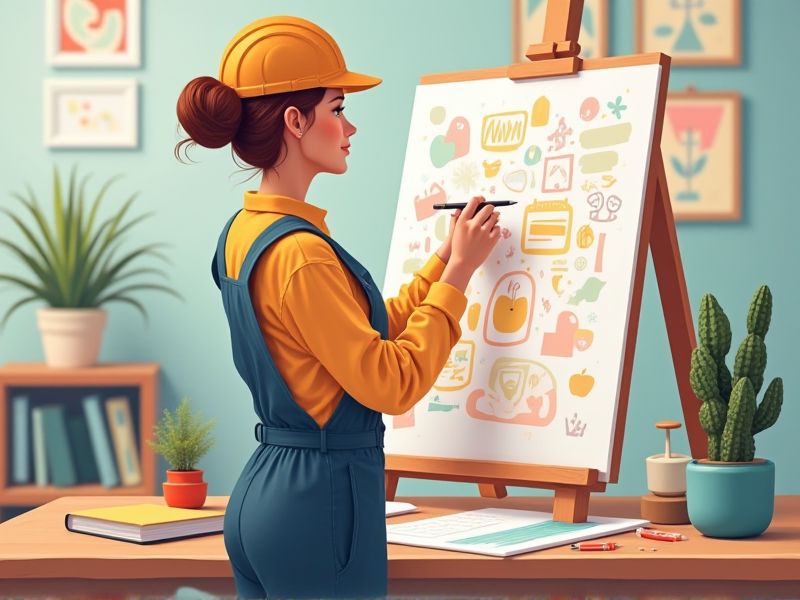
Pablo Picasso once said, "Learn the rules like a pro, so you can break them like an artist," highlighting the importance of mastering the fundamentals before innovating. This approach allows artists to understand the boundaries of their craft, enabling them to push beyond them creatively. By first learning the rules, artists can then experiment and break free from conventions, leading to unique and innovative works. This mindset is crucial for artistic growth, as it fosters both technical skill and creative freedom.
How to Be Better at Art
Practice regularly
Regular and consistent practice is the cornerstone of developing your artistic skills, as it builds muscle memory and fosters creativity. By engaging with your art daily, you're able to observe your progress and refine your techniques over time. Experimenting with different styles and mediums during practice sessions can also broaden your understanding and flexibility in art. Consistent practice not only boosts confidence but also deepens your intuition about composition, shading, and color balance, paving the way for continuous growth.
Study the fundamentals
Start by mastering the essential building blocks like color theory, composition, and perspective, as these fundamentals form the backbone of your artistic expression. Gaining a solid grasp of these basics allows you to translate your observations and ideas into visually compelling works. Regular practice and focused study help reinforce these skills, ensuring that every piece you create is a step toward improvement. Over time, this strong foundation enables you to experiment with advanced techniques and develop a unique artistic voice.
Experiment with different mediums
Experimenting with different mediums can expand your creative toolkit and help you discover unique techniques. Trying materials like oils, watercolors, acrylics, or even digital platforms provides diverse approaches to brush strokes and textures. By exploring these variations, you'll learn how each medium interacts with your artistic style, allowing you to adapt and refine your technique. Carefully observe the outcomes, document your process, and adjust your methods, which will lead to measurable improvements in your art over time.
Analyze works by masters
Begin by closely studying the composition, brushwork, and color schemes used in masterworks to understand their design choices. Deliberately comparing several pieces helps reveal recurring techniques that lead to strong visual narratives. Recognizing how these artistic choices influence the viewer's emotions can refine your approach to conveying meaning in your own work. Integrating these observations into regular practice amplifies both technical precision and creative expression.
Draw from life
Drawing from life sharpens your observational skills by forcing you to confront the complexities of real-world subjects, like lighting, texture, and proportion. Engaging directly with your subject matter cultivates a deeper understanding of spatial relationships, which can significantly enhance the realism in your art. This practice not only refines your technical ability but also builds adaptability, as you learn to capture nuances in dynamic, ever-changing environments. Consistently integrating life drawing into your routine will lead to more confident, insightful creative choices and a noticeable improvement in your overall technique.
Seek constructive feedback
Seeking constructive feedback means actively asking for insights and critiques on your work from peers, mentors, or the broader art community. This process provides actionable data that pinpoints both strengths and areas for development in your technique and style. By incorporating diverse perspectives, you can identify blind spots and adjust your approach, ultimately accelerating your learning curve. Regularly engaging in this feedback loop transforms criticism into strategic improvements, leading to long-term growth in your artistic abilities.
Set personal challenges
Establishing personal challenges forces you to step outside your comfort zone, which in turn accelerates your creative development. By setting specific goals, you transform abstract ambitions into measurable tasks that stimulate continuous improvement. Tackling these challenges naturally leads to discovering new techniques and refining your style through direct experimentation. As a consequence, your ongoing commitment to overcoming obstacles ultimately results in a richer and more dynamic artistic skill set.
Observe your progress over time
Observing your progress over time allows you to see tangible improvements in your style and technique, creating a roadmap for future growth. Tracking these changes empowers you to pinpoint which methods resonate most effectively with your creative process. By comparing earlier works with current ones, you can identify specific areas where consistent practice has paid off. This reflective habit ultimately builds both confidence and precision, steering your artistic journey toward continual improvement.
Embrace experimentation and mistakes
Experimentation is a cornerstone of artistic growth, as it encourages you to explore new methods and mediums without fearing the outcome. Embracing mistakes provides tangible feedback that refines your techniques and clarifies your creative vision. Each error becomes a data point, illuminating what resonates with your style while highlighting areas for improvement. In this iterative process, taking risks leads to continuous evolution and ultimately unlocks your full artistic potential.
Maintain a creative journal
Keeping a creative journal allows you to capture fleeting ideas and observations that can evolve into impactful artworks. By routinely jotting down sketches, notes, and inspirations, you foster a habit of continuous reflection and experimentation. This practice not only helps track your artistic progress but also uncovers patterns in your creative process over time. In turn, maintaining a creative journal builds a personal resource that can spark new projects and refine your artistic style.
Summary
Consistent practice strengthens techniques and nurtures creative confidence. Focusing on fundamental principles lays a solid foundation for understanding artistic composition and design. Experimenting with various mediums broadens skill sets and fosters innovative expression. Together, these approaches cultivate continual improvement, leading to deeper insight and success in art.
